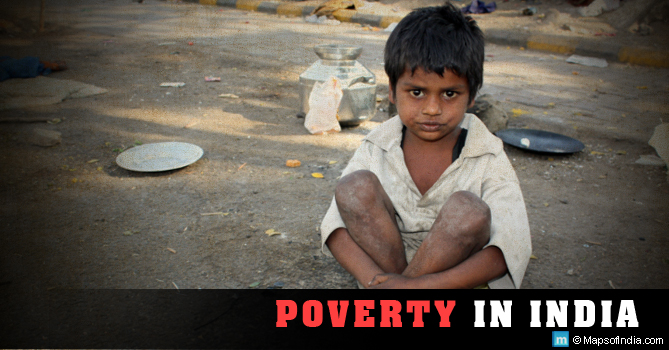There are many ways of defining and estimating poverty in a country, such as India. For example, the Tendulkar Committee in India based its calculations of subsistence level on the requirement of cereal, pulses, milk, edible oil, non-vegetarian items, vegetables, fresh fruits, dry fruits, sugar, salt & spices, other food, fuel, clothing, footwear, education, medical (non-institutional and institutional), entertainment, personal & toilet goods, other goods, other services and durables. Hence, as per Tendulkar Committee methodology, the national poverty line (in Rs per capita per month) for the year 2011-12 was calculated at Rs 816 for rural areas and Rs 1000 for urban areas. Using this methodology, the National Sample Survey Organisation estimated poverty at 21.9% of the population (269 million) in 2011-12. That means in the category of poor fell the people whose daily income was less than Rs 27 a day in villages and Rs 33 a day in cities. On the other hand, the subsequent Rangarajan Committee pegged the poverty line at Rs 32 in rural areas and Rs 47 in urban areas. On this basis, the number of poor living below the poverty line in India in 2011-2012 was revised to 29.5% of the population (363 million).
In contrast, the international poverty line as updated in October 2015 by the World Bank stands at US$1.90 per day (2011 PPP). In 2011, 21.2% of the total population in India was estimated to be living below this poverty line, as per the World Bank data.
Household expenditure is considered for calculating the poverty count in India. In this method, the purchasing power of people for buying food and some essential non-food items is taken into account. In the last few years, though the condition in cities continues to be more or less the same, the government welfare programmes have really helped reduce the incidence of poverty in rural India. Schemes such as MGNREGS have resulted in a decrease in poverty in rural areas at a faster pace than their urban counterparts.
But in spite of all the attempts, the overall number of poor in India is still increasing and becoming a hurdle. Poverty is just like a disease to which many other problems such as crime, low-paced development, etc are associated. There are a number of people in India who still live on the streets and beg for the whole day to eat a meal. Underprivileged children are unable to attend school and, and those have the opportunity to drop out after a year or so. People below the poverty line live in unhygienic conditions and are so prone to many health problems. With this, the vicious cycle of poor health, lack of education and more poverty keeps on increasing.
Facts on Poverty in India
Who comes in the category of the poorest class in India?
Tribal people, Dalits and labour class including farmworkers in villages and casual workers in cities are still very poor and make the poorest class in India.
Where do the majority of poor live in India?
60% of the poor still reside in the states of Bihar, Jharkhand, Odisha, Madhya Pradesh, Chattisgarh, Uttar Pradesh and Uttarakhand. The reason for these states to be in the category of the poorest state is because 85% of tribal people live there. Also, most of these regions are either flood-prone or suffer from calamities. These conditions hamper agriculture to a great extent, on which the household income of these groups depends.
According to the Global Hunger Index Report 2018 by the International Food Research Institute, India ranks 103 in the Global Hunger Index (GHI). Though there is no shortage of food production in India, our nation still has 35.8% of children under five in the underweight category. India is working hard to become a superpower in 2020, but such statistics are worrisome, as our nation still lags behind in improving GHI. At the same time, India seems to have achieved commendable success towards poverty eradication, because it is no longer the country with the largest number of poor people.
In 2018, for the first time in decades, Nigeria pipped India to the top slot in terms of the total number of people living in extreme poverty. As per World Poverty Clock, India’s figure of 70.6 million was surpassed by Nigeria’s 87 million people living in extreme poverty.
Moreover, according to a Sustainable Development Goals Report of the United Nations Development Program released in 2018, India has made significant progress: “Between 2005-06 and 2015-16, the incidence of multidimensional poverty in India was almost halved, climbing down to 27.5 percent from 54.7 percent as per the 2018 global Multidimensional Poverty Index report. Within ten years, the number of poor people in India fell by more than 271 million (from 635 million to 364 million). This MPI index measures progress across 3 key dimensions of health, education and living standards, and uses 10 indicators – nutrition, child mortality, years of schooling, school attendance, sanitation, cooking fuel, drinking water, electricity, housing and assets. People who lag behind in at least a third of the MPI’s components are defined as multidimensionally poor.
Causes of Poverty in India
The high population growth rate is one of the major reasons of poverty in India. This further leads to a high level of illiteracy, poor health care facilities and lack of access to financial resources. Also, high population growth affects the per capita income and makes per capita income even lower. It is expected that the population in India will reach 1.5 billion by 2026 and then India will be the largest nation in the world. But India’s economy is not growing at the same pace. This means a shortage of jobs. For this much population, near about 20 million new jobs would be required. The number of poor will keep on increasing if such a big number of jobs won’t be created.
The ever-increasing prices of even basic commodities is another reason for poverty. A person below the poverty line finds it difficult to survive. The caste system and unequal distribution of income and resources is another reason for poverty in India.
Apart from all these, unskilled workers are paid very low in spite of the hard work they put in daily. The problem lies with the unorganized sector as owners do not bother with the way their workers live and the amount they earn. Their area of concern is just cost-cutting and more profit. Because of the number of workers looking for a job is higher than the jobs available, unskilled workers have no other option but to work for less money. The government should really find a way to impose minimum wage standards for these workers. At the same time, the government should ensure that this is implemented well.
Poverty must be eradicated from India as every person has the right to live a healthy life.
Related Links:
- India and Global Hunger Index
- Begging in India
- Can Modi Change India?
- Why India is still a poor country?
- Overpopulation in India – Causes, Effects and How to Control it?
- Causes of rural poverty and Anti-poverty schemes in India
- Why a poor person cannot wear quality clothes?
- Family planning in India
- Overpopulation in India
- Human Trafficking in India
- Child Trafficking
- Child labour in India
- Why India is a Poor Country?





